Modeling the Relative Contributions of Land Use Change and Harvest to Forest Landscape Change in the Taihe County, China
Abstract
:1. Introduction
2. Materials and Methods
2.1. Study Area
2.2. Modeling Framework
2.3. Land-Use Change Simulation
- (1)
- Calculated the transition matrix using Markov. The transition area matrix and transition probability matrix were obtained through the Markov module, which were derived from the land use maps in 2005 and 2010.
- (2)
- Generated conditional probability maps. The Multi-Criteria Evaluation (MCE) module in IDRISI was used to generate the conditional probability maps for each land use type [30]. In this study, many factors were considered, such as the slope, distance to the water body, population, major road, and town center, as well as their influence on each land use type. Then, these maps were standardized and unified onto one conditional map for the CA-Markov simulation input.
- (3)
- Simulated land use using the CA-Markov model. First, CA filters were determined as a standard 5 × 5 contiguity filter in this study. Second, the precision of the simulation was tested. The spatial consistency was checked using the overall Kappa spatial correlation statistic between the observed 2010 and simulated 2010 land use datasets. The Kappa index is the summary statistics [31]. The actual and simulated land use maps in 2010 are shown in Figure 3. The results showed that the spatial pattern of land use type was consistent. The overall Kappa statistic was 0.9176, which was well above 0.80, demonstrating that the transition rules could be used to predict the spatial pattern of land use in our study area [32]. Finally, the starting point and number of iterations were decided. We took the land use map from 2010 as a starting point and selected 10 CA iterations to simulate the predicted spatial pattern of land use in 2020. Then, the 2020 land use map was used as the basis to simulate the predicted land use pattern in 2030 with 10 further CA iterations, and so on, until the year 2050.
2.4. Forest Landscape Simulation
2.5. Quantifying the Relative Contributions of Land Use Change and Harvest
3. Results
3.1. Land-Use Change Simulation
3.2. Forest Landscape Simulation
3.3. Relative Contributions of Land Use Change and Harvest
4. Discussion
4.1. Uncertainties and Caveats
4.2. Implications of Quantitative Simulation for Future Management and Planning
5. Conclusions
Acknowledgments
Author Contributions
Conflicts of Interest
Abbreviations
| CA | Cellular Automata |
| EBF | Evergreen Broad-leaved Forests |
| DBF | Deciduous Broad-leaved Forests |
| MF | Masson pine Forests |
| SF | Slash pine Forests |
| CF | Chinese fir Forests |
| OF | Other Forests |
| NF | Non-Forestland |
| QYZ station | Qian Yan Zhou ecological station |
| PAR | Photosynthetically Active Radiation |
| MCE | Multi-Criteria Evaluation |
| SEP | Species Establishment Probability |
| ANPP | Aboveground Net Primary Production |
| WHC | Water Holding Capacity |
| WUE | Water Use Efficiency |
| FL | Forestland |
| GL | Grass Land |
| WB | Water Body |
| BL | Built-up Land |
| UL | Unused Land |
| AL | Arable Land |
References
- Food and Agriculture Organization of the United Nations. Global Forest Resource Assessment 2010; FAO: Rome, Italy, 2010. [Google Scholar]
- Ninan, K.N.; Inoue, M. Valuing forest ecosystem services: What we know and what we don’t. Ecol. Econ. 2013, 93, 137–149. [Google Scholar] [CrossRef]
- Drummond, M.A.; Loveland, T.R. Land-use pressure and a transition to forest-cover loss in the eastern united states. Bioscience 2010, 60, 286–298. [Google Scholar] [CrossRef]
- Hansen, M.C.; Potapov, P.V.; Moore, R.; Hancher, M.; Turubanova, S.A.; Tyukavina, A.; Thau, D.; Stehman, S.V.; Goetz, S.J.; Loveland, T.R.; et al. High-resolution gloabl maps of 21st-century forest cover change. Science 2013, 342, 850–853. [Google Scholar] [CrossRef] [PubMed]
- Hansen, A.J.; Neilson, R.P.; Dale, V.H.; Flather, C.H.; Iverson, L.R.; Currie, D.J.; Shafer, S.; Cook, R.; Bartlein, P.J. Global change in forests: Responses of species, communities, and biomes. Bioscience 2001, 51, 775–779. [Google Scholar] [CrossRef]
- Newton, A.C.; Echeverría, C.; Cantarello, E.; Bolados, G. Projecting impacts of human disturbances to inform conservation planning and management in a dryland forest landscape. Biol. Conserv. 2011, 144, 1949–1960. [Google Scholar] [CrossRef]
- Gustafson, E.J.; Shvidenko, A.Z.; Sturtevant, B.R.; Scheller, R.M. Predicting global change effects on forest biomass and composition in south-central siberia. Ecol. Appl. 2010, 20, 700–715. [Google Scholar] [CrossRef] [PubMed]
- Barlow, J.; Lennox, G.D.; Ferreira, J.; Berenguer, E.; Lees, A.C.; Mac Nally, R.; Thomson, J.R.; Ferraz, S.F.; Louzada, J.; Oliveira, V.H.; et al. Anthropogenic disturbance in tropical forests can double biodiversity loss from harvest. Nature 2016, 535, 144–147. [Google Scholar] [CrossRef] [PubMed]
- Jõgiste, K.; Jonsson, B.G.; Kuuluvainen, T.; Gauthier, S.; Moser, W.K. Forest landscape mosaics: Disturbance, restoration, and management at times of global change. Can. J. For. Res. 2015, 45, v–vi. [Google Scholar] [CrossRef]
- Yeboah, D.; Chen, H.Y.H. Diversity–disturbance relationship in forest landscapes. Landsc. Ecol. 2015, 31, 981–987. [Google Scholar] [CrossRef]
- Rudel, T.K.; Coomes, O.T.; Moran, E.; Achard, F.; Angelsen, A.; Xu, J.; Lambin, E. Forest transitions: Towards a global understanding of land use change. Glob. Environ. Chang. 2005, 15, 23–31. [Google Scholar] [CrossRef]
- Steenberg, J.W.N.; Duinker, P.N.; Bush, P.G. Modelling the effects of climate change and timber harvest on the forests of central Nova Scotia, Canada. Ann. For. Sci. 2012, 70, 61–73. [Google Scholar] [CrossRef]
- Scheller, R.M.; Mladenoff, D.J. A spatially interactive simulation of climate change, harvesting, wind, and tree species migration and projected changes to forest composition and biomass in northern Wisconsin, USA. Glob. Chang. Biol. 2005, 11, 307–321. [Google Scholar] [CrossRef]
- Thompson, J.R.; Foster, D.R.; Scheller, R.M.; Kittredge, D. The influence of land use and climate change on forest biomass and composition in Massachusetts, USA. Ecol. Appl. 2011, 21, 2425–2444. [Google Scholar] [CrossRef] [PubMed]
- Abood, S.A.; Lee, J.S.H.; Burivalova, Z.; Garcia-Ulloa, J.; Koh, L.P. Relative contributions of the Logging, Fiber, Oil Palm, and mining industries to forest loss in Indonesia. Conserv. Lett. 2015, 8, 58–67. [Google Scholar] [CrossRef]
- Fang, J.Y.; Guo, Z.D.; Hu, H.F.; Kato, T.; Muraoka, H.; Son, Y. Forest biomass carbon sinks in East Asia, with special reference to the relative contributions of forest expansion and forest growth. Glob. Chang. Biol. 2014, 20, 2019–2030. [Google Scholar] [CrossRef] [PubMed]
- Pallett, R.N.; Sale, G. The relative contributions of tree improvement and cultural practice toward productivity gains in Eucalyptus pulpwood stands. For. Ecol. Manag. 2004, 193, 33–43. [Google Scholar] [CrossRef]
- Dai, E.; Wu, Z.; Wang, X.; Fu, H.; Xi, W.; Pan, T. Progress and prospect of research on forest landscape model. J. Geogr. Sci. 2014, 25, 113–128. [Google Scholar] [CrossRef]
- Sang, L.; Zhang, C.; Yang, J.; Zhu, D.; Yun, W. Simulation of land use spatial pattern of towns and villages based on CA-Markov model. Math. Comput. Model. 2011, 54, 938–943. [Google Scholar] [CrossRef]
- Adhikari, S.; Southworth, J. Simulating forest cover changes of Bannerghatta national park based on a CA-Markov model: A remote sensing approach. Remote Sens. 2012, 4, 3215–3243. [Google Scholar] [CrossRef]
- Yang, X.; Zheng, X.; Chen, R. A land use change model: Integrating landscape pattern indexes and Markov-CA. Ecol. Model. 2014, 283, 1–7. [Google Scholar] [CrossRef]
- Scheller, R.M.; Domingo, J.B.; Sturtevant, B.R.; Williams, J.S.; Rudy, A.; Gustafson, E.J.; Mladenoff, D.J. Design, development, and application of LANDIS-II, a spatial landscape simulation model with flexible temporal and spatial resolution. Ecol. Model. 2007, 201, 409–419. [Google Scholar] [CrossRef]
- Dai, E.; Wu, Z.; Ge, Q.; Xi, W.; Wang, X. Predicting the responses of forest distribution and aboveground biomass to climate change under RCPs scenarios in southern China. Glob. Chang. Biol. 2016, 22, 3642–3661. [Google Scholar] [CrossRef] [PubMed]
- Gustafson, E.J.; Shvidenko, A.Z.; Scheller, R.M. Effectiveness of forest management strategies to mitigate effects of global change in south-central Siberia. Can. J. For. Res. 2011, 41, 1405–1421. [Google Scholar] [CrossRef]
- Liu, S.R.; Wu, S.R.; Wang, H. Managing planted forests for multiple uses under a changing environment in China. NZ J. For. Sci. 2014, 44, S3. [Google Scholar] [CrossRef]
- Wang, Y.; Li, Q.; Wang, H.; Wen, X.; Yang, F.; Ma, Z.; Liu, Y.; Sun, X.; Yu, G. Precipitation frequency controls interannual variation of soil respiration by affecting soil moisture in a subtropical forest plantation. Can. J. For. Res. 2011, 41, 1897–1906. [Google Scholar] [CrossRef]
- South Hilly Scientific Expedition by Chinese Academy of Sciences. Natural Resource and Agricultural Regionalization in Taihe County, Jiangxi Province; Energy Press: Beijing, China, 1982. [Google Scholar]
- Han, J.; Hayashi, Y.; Cao, X.; Imura, H. Application of an integrated system dynamics and cellular automata model for urban growth assessment: A case study of Shanghai, China. Landsc. Urban Plan. 2009, 91, 133–141. [Google Scholar] [CrossRef]
- Clark Labs. IDRISI Geographic Information Systems and Remote Sensing Software; Clark Labs: Worcester, MA, USA, 2006. [Google Scholar]
- Eastman, J.R.; Jiang, H.; Toledano, J. Multi-criteria and multi-objective decision making for land allocation using GIS. In Multicriteria Analysis for Land-Use Management; Beinat, E., Nijkamp, P., Eds.; Springer: Dordrecht, The Netherlands, 1998; pp. 227–251. [Google Scholar]
- Pontius, R.G.J.; Huffaker, D.; Denman, K. Useful techniques of validation for spatially explicit land-change models. Ecol. Model. 2004, 179, 445–461. [Google Scholar] [CrossRef]
- Viera, A.J.; Garrett, J.M. Understanding interobserver agreement: The kappa statistic. Fam. Med. 2005, 37, 360–363. [Google Scholar] [PubMed]
- Scheller, R.M.; Mladenoff, D.J. A forest growth and biomass module for a landscape simulation model, LANDIS: Design, validation, and application. Ecol. Model. 2004, 180, 211–229. [Google Scholar] [CrossRef]
- Mladenoff, D.J.; Host, G.E.; Boeder, J.; Crow, T.R. LANDIS: A spatial model of forest landscapedisturbance, succession and management. In GIS and Environmental Modeling: Progress and Research Issues; Goodchild, M.F., Steyaert, L.T., Parks, B.O., Eds.; GIS World Books: Fort Collins, CO, USA, 1996. [Google Scholar]
- Mladenoff, D.J.; He, H. Design and behavior of LANDIS, an object-oriented model of forest landscape disturbance and succession. In Spatial Modeling Offorest Landscape Change: Approaches and Applications; Mladenoff, D.J., Baker, W.L., Eds.; Cambridge University Press: Cambridge, UK, 1999. [Google Scholar]
- De Bruijn, A.; Gustafson, E.J.; Sturtevant, B.R.; Foster, J.R.; Miranda, B.R.; Lichti, N.I.; Jacobs, D.F. Toward more robust projections of forest landscape dynamics under novel environmental conditions: Embedding PnET within LANDIS-II. Ecol. Model. 2014, 287, 44–57. [Google Scholar] [CrossRef]
- Xu, C.; Gertner, G.Z.; Scheller, R.M. Importance of colonization and competition in forest landscape response to global climatic change. Clim. Chang. 2011, 110, 53–83. [Google Scholar] [CrossRef]
- Chen, X.; Li, W.; Pan, Q.; Yang, M. Studies on spacial distribution and the spread distance of pollen in Chinese fir seed orchards. J. Beijing For. Univ. 1996, 18, 24–30. [Google Scholar]
- Editorial Committee of Forest of China. Forest of China; China Forestry Publishing House: Beijing, China, 2000; Volumes 2–3. [Google Scholar]
- Yu, Q.; Wang, S.; Shi, H.; Huang, K.; Zhou, L. An evaluation of spaceborne imaging spectrometry for estimation of forest canopy nitrogen concentration in a subtropical conifer plantation of southern China. J. Resour. Ecol. 2014, 5, 1–10. [Google Scholar]
- Wu, Z.L. Chinese Fir; China Forestry Publish House: Beijing, China, 1984. [Google Scholar]
- He, K.; Liu, R.L. Encyclopedia of Chinese Agriculture: Forestry Volume; China Agriculture Press: Beijing, China, 1989. [Google Scholar]
- Sheng, W.; Ren, S.; Yu, G.; Fang, H.; Jiang, C.; Zhang, M. Patterns and driving factors of WUE and NUE in natural forest ecosystems along the north-south transect of eastern China. J. Geogr. Sci. 2011, 21, 651–665. [Google Scholar] [CrossRef]
- Aber, J.D.; Federer, C.A. A generalized, lumped-parameter model of photosynthesis, evapotranspiration and net primary production in temperate and boreal forest ecosystems. Oecologia 1992, 92, 463–474. [Google Scholar] [CrossRef] [PubMed]
- Aber, J.D.; Ollinger, S.V.; Federer, C.A.; Reich, P.B.; Goulden, M.L.; Kicklighter, D.W.; Melillo, J.M.; Lathrop R.G., Jr. Predicting the effects of climate change on water yield and forest production in the northeastern United States. Clim. Res. 1995, 5, 207–222. [Google Scholar] [CrossRef]
- Aber, J.D.; Driscoll, C.T. Effects of land use, climate variation, and N deposition on N cycling and C storage in northern hardwood forests. Glob. Biogeochem. Cycles 1997, 11, 639–648. [Google Scholar] [CrossRef]
- Ollinger, S.V.; Aber, J.D.; Reich, P.B.; Freuder, R.J. Interactive effects of nitrogen deposition, tropospheric ozone, elevated CO2 and land use history on the carbon dynamics of northern hardwood forests. Glob. Chang. Biol. 2002, 8, 545–562. [Google Scholar] [CrossRef]
- Liu, Y.P.; Yu, D.Y.; Xun, B.; Sun, Y.; Hao, R.F. The potential effects of climate change on the distribution and productivity of Cunninghamia lanceolata in China. Environ. Monit. Assess. 2014, 186, 135–149. [Google Scholar] [CrossRef] [PubMed]
- Robinson, D.T.; Sun, S.; Hutchins, M.; Riolo, R.L.; Brown, D.G.; Parker, D.C.; Filatova, T.; Currie, W.S.; Kiger, S. Effects of land markets and land management on ecosystem function: A framework for modelling exurban land-change. Environ. Model. Softw. 2013, 45, 129–140. [Google Scholar] [CrossRef]
- Berland, A.; Shuman, B.; Manson, S.M. Simulated importance of dispersal, disturbance, and landscape history in long-term ecosystem change in the big woods of Minnesota. Ecosystems 2011, 14, 398–414. [Google Scholar] [CrossRef]
- He, H.; Mladenoff, D.J. Spatially explicit and stochastic simulation of forest landscape fire disturbance and succession. Ecology 1999, 80, 81–99. [Google Scholar] [CrossRef]
- Leroux, S.J.; Rayfield, B.; Rouget, M. Methods and tools for addressing natural disturbance dynamics in conservation planning for wilderness areas. Divers. Distrib. 2014, 20, 258–271. [Google Scholar] [CrossRef]
- Briassoulis, H. Analysis of Land Use Change: Theoretical and Modelling Approaches; Regional Research Institute, West Virginia University: Morgantown, WV, USA, 2000. [Google Scholar]
- Tattoni, C.; Ciolli, M.; Ferretti, F. The fate of priority areas for conservation in protected areas: A fine-scale Markov chain approach. Environ. Manag. 2011, 47, 263–278. [Google Scholar] [CrossRef] [PubMed]
- Gustafson, E.J.; Crow, T.R. Simulating the effects of alternative forest management strategies on landscape strcuture. J. Environ. Manag. 1996, 46, 77–94. [Google Scholar] [CrossRef]
- Wu, Z.; Dai, E.; Ge, Q.; Xi, W.; Wang, X. Modelling the integrated effects of land use and climate change scenarios on forest ecosystem aboveground biomass, a case study in Taihe County of China. J. Geogr. Sci. 2017, 27, 205–222. [Google Scholar] [CrossRef]
- Gustafson, E.J.; Shifley, S.R.; Mladenoff, D.J.; Nimerfro, K.K.; He, H. Spatial simulation of forest succession and timber harvesting using LANDIS. Can. J. For. Res. 2000, 30, 32–43. [Google Scholar] [CrossRef]
- Oliveira, P.J.C.; Asner, G.P.; Knapp, D.E.; Almeyda, A.; Galván-Gildemeister, R.; Keene, S.; Raybin, R.F.; Smith, R.C. Land-ues allocation protects the Peruvian Amazon. Science 2007, 317, 1233–1236. [Google Scholar] [CrossRef] [PubMed]
- Scheller, R.M.; Mladenoff, D.J. Simulated effects of climate change, fragementation, and inter-specific competition on tree species migration in northern Wisconsin, USA. Clim. Res. 2008, 36, 191–202. [Google Scholar] [CrossRef]
- Hong, S.K.; Nakagoshi, N.; Kamada, M. Human impacts on pine-dominated vegetation in rural landscapes in Korea and western Japan. Plant Ecol. 1995, 116, 161–172. [Google Scholar] [CrossRef]



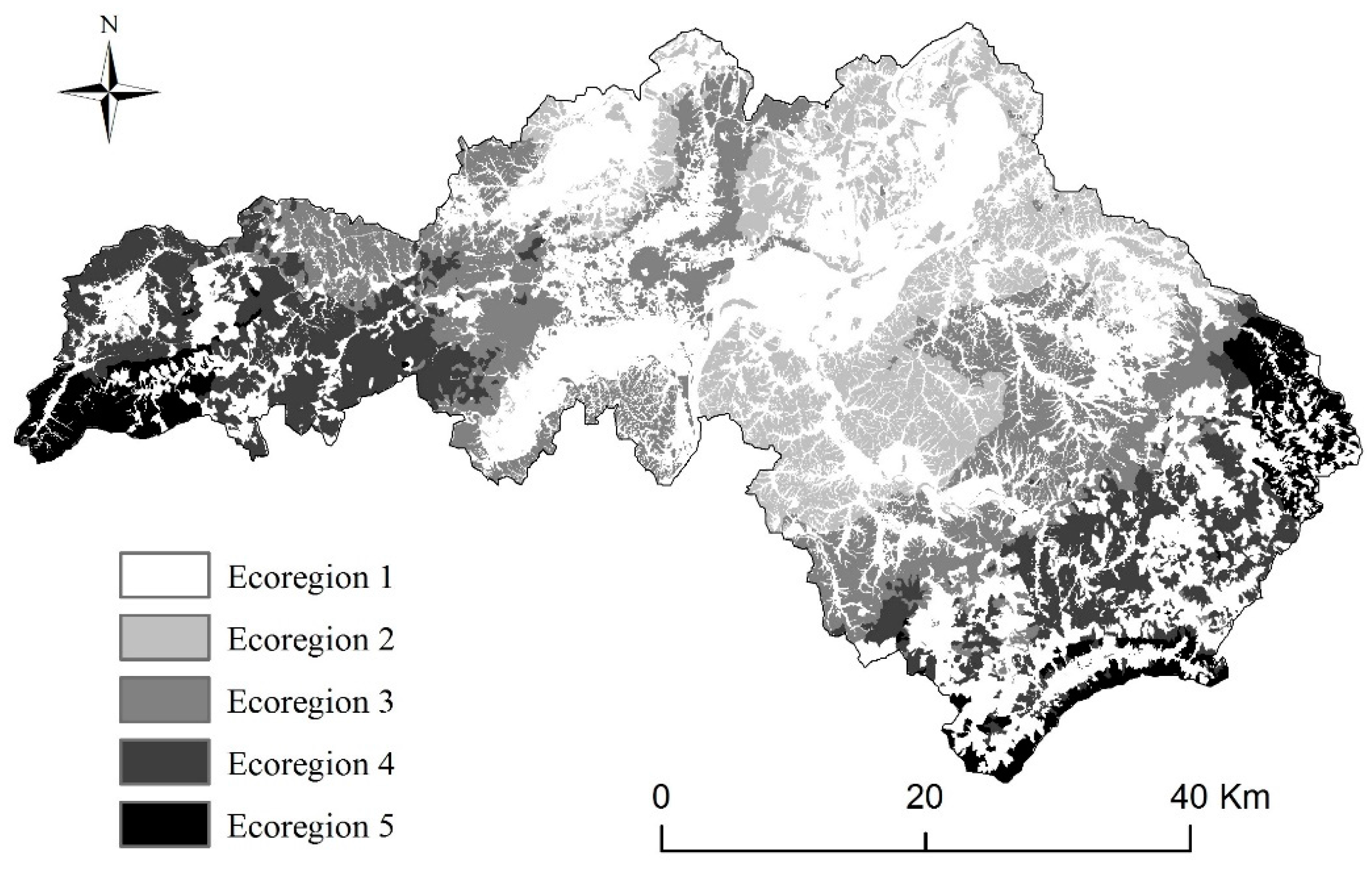
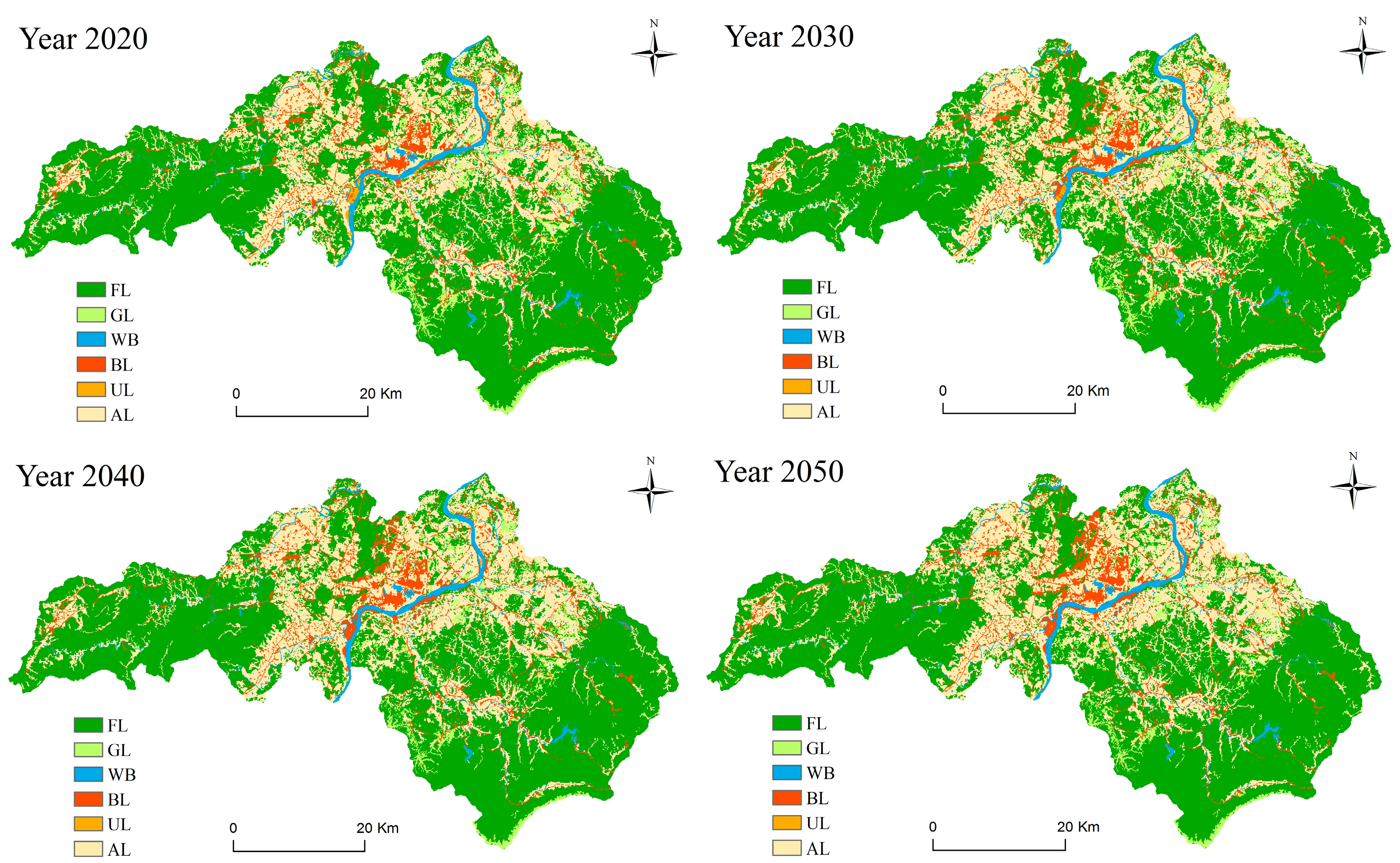
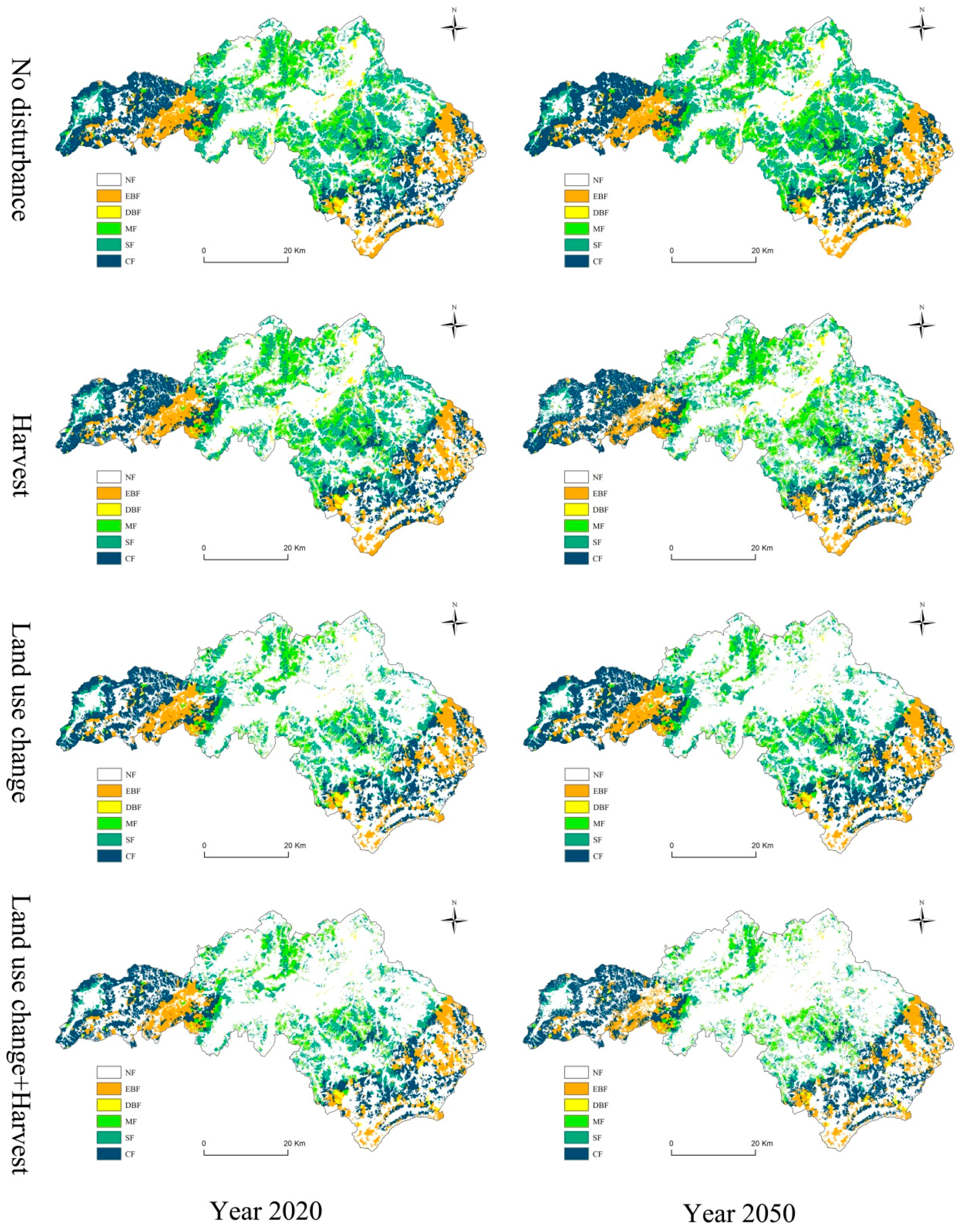
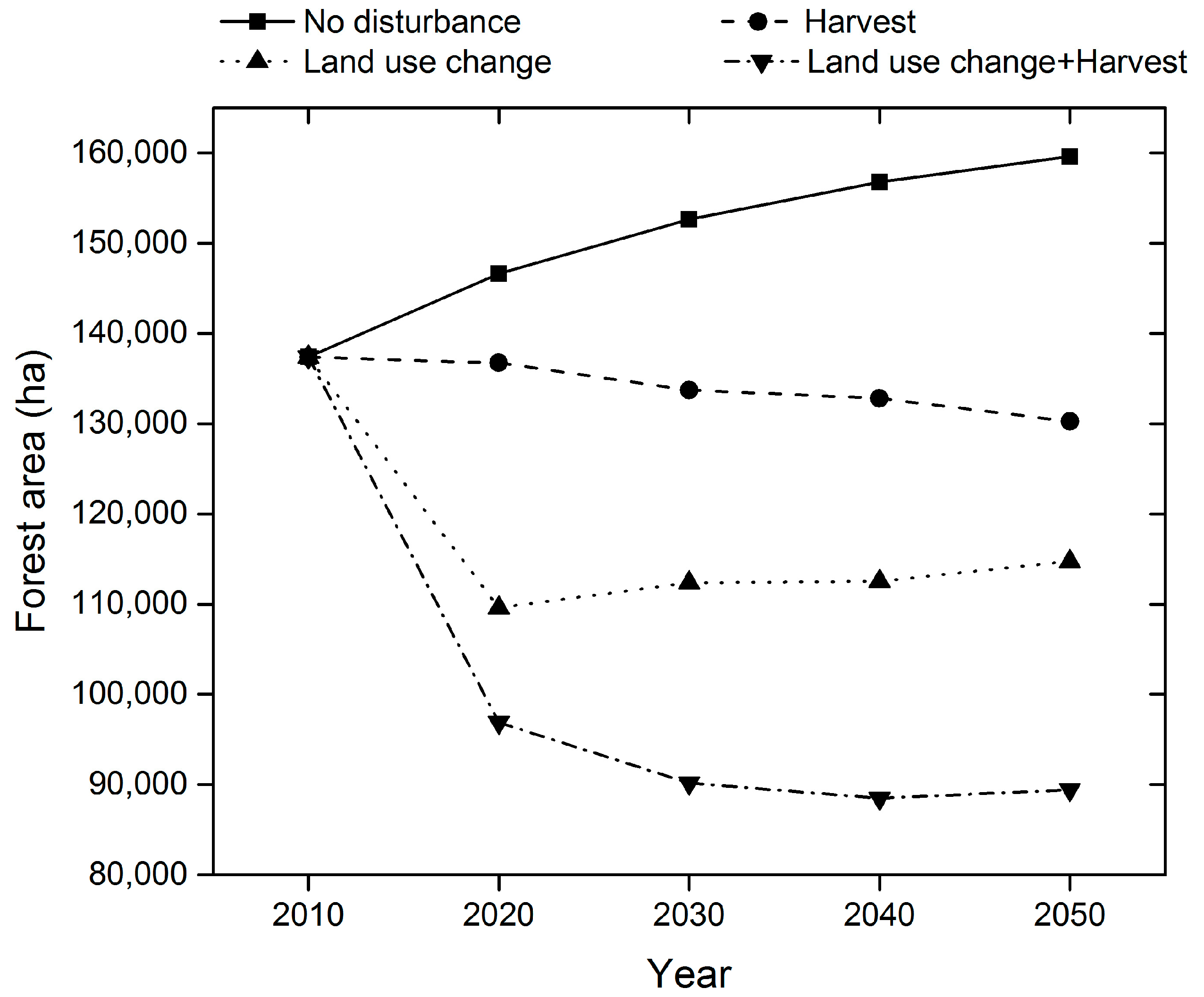
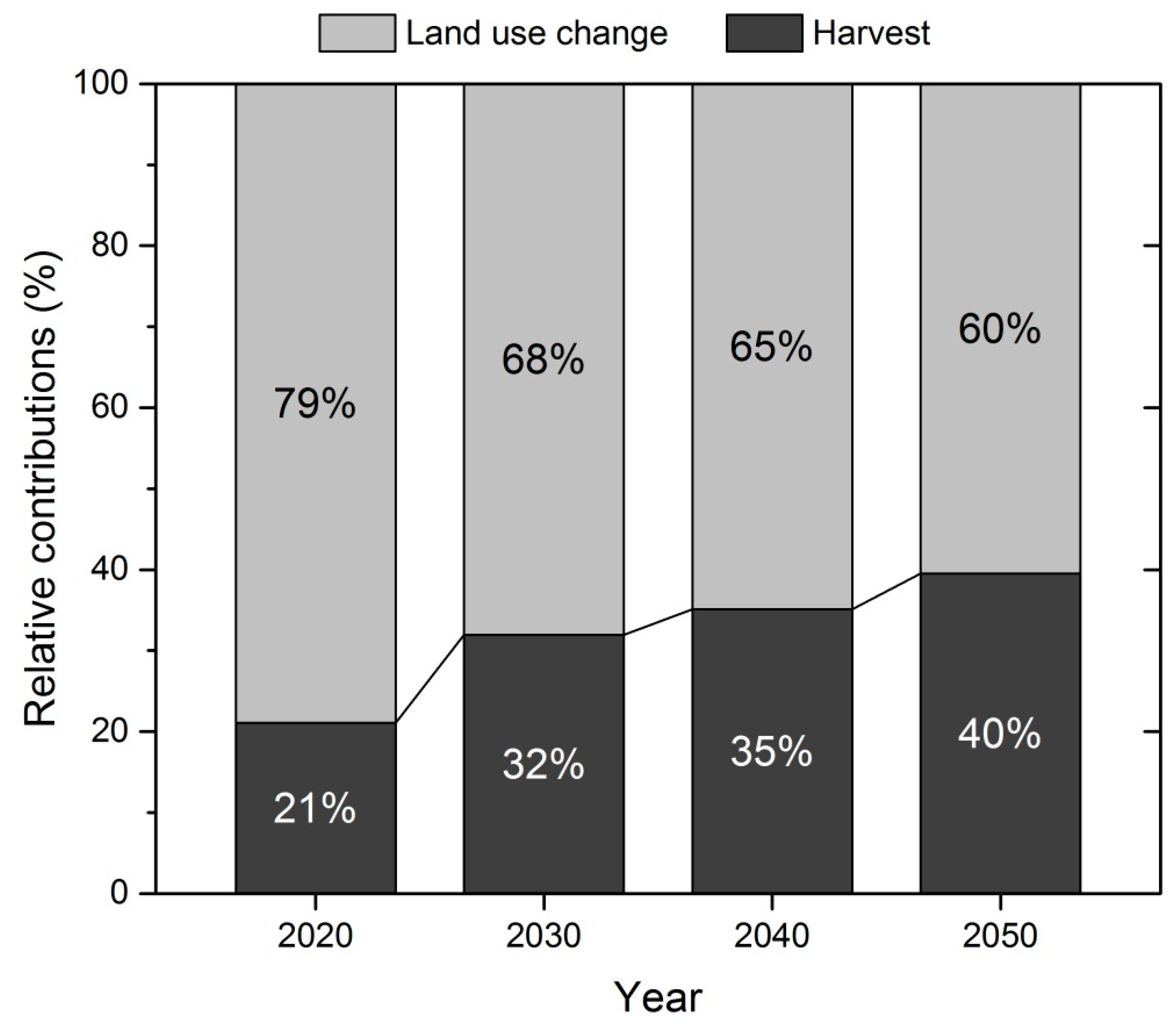
| Species | Longevity (Year) | Sexual Maturity (Year) | Shade Tol. | Seed Dispersal Dist. | |
|---|---|---|---|---|---|
| Effective (m) | Maximum (m) | ||||
| Cunninghamia lanceolata | 200 | 10 | 1 | 200 | 500 |
| Cupressus funebris | 500 | 35 | 2 | 70 | 200 |
| Pinus massoniana | 200 | 10 | 1 | 200 | 500 |
| Pinus elliottii | 200 | 10 | 1 | 200 | 500 |
| Schima superba | 300 | 20 | 5 | 20 | 200 |
| Cinnamomum camphora | 1000 | 15 | 4 | 50 | 120 |
| Phoebe zhennan | 1000 | 50 | 5 | 40 | 120 |
| Castanopsis eyrei | 200 | 20 | 5 | 50 | 120 |
| Castanopsis fargesii | 150 | 30 | 5 | 60 | 250 |
| Quercus fabri | 120 | 15 | 4 | 20 | 200 |
| Cyclobalanopsis gracilis | 200 | 7 | 4 | 20 | 50 |
| Liquidambar formosana | 130 | 8 | 3 | 100 | 375 |
| Betula luminifera | 100 | 15 | 2 | 150 | 400 |
| Alnus cremastogyne | 125 | 5 | 3 | 15 | 60 |
| Alniphyllum fortunei | 120 | 15 | 2 | 250 | 500 |
| Sassafras tzumu | 120 | 20 | 3 | 50 | 150 |
| Melia azedarach | 80 | 5 | 2 | 200 | 400 |
| Populus deltoides | 90 | 10 | 2 | 150 | 500 |
| Type | Initial | No Disturbance | Harvest | Land Use Change | Land Use Change + Harvest | ||||
|---|---|---|---|---|---|---|---|---|---|
| 2010 | 2050 | 2050 | 2050 | 2050 | |||||
| Area (ha) | Area (ha) | Rate (%) | Area (ha) | Rate (%) | Area (ha) | Rate (%) | Area (ha) | Rate (%) | |
| EBF | 23,105 | 26,645 | 15.3 | 22,796 | −1.3 | 23,813 | 3.1 | 19,459 | −15.8 |
| DBF | 2877 | 3704 | 28.7 | 3821 | 32.8 | 2118 | −26.4 | 2122 | −26.2 |
| MF | 27,282 | 32,700 | 19.9 | 29,440 | 7.9 | 18,123 | −33.6 | 15,602 | −42.8 |
| SF | 43,170 | 49,887 | 15.6 | 29,010 | −32.8 | 29,096 | −32.6 | 14,027 | −67.5 |
| CF | 40,943 | 46,686 | 14.0 | 45,204 | 10.4 | 41,607 | 1.6 | 38,224 | −6.6 |
| Total | 137,377 | 159,622 | 16.2 | 130,271 | −5.2 | 114,757 | −16.5 | 89,434 | −34.9 |
© 2017 by the authors. Licensee MDPI, Basel, Switzerland. This article is an open access article distributed under the terms and conditions of the Creative Commons Attribution (CC BY) license (http://creativecommons.org/licenses/by/4.0/).
Share and Cite
Wu, Z.; Ge, Q.; Dai, E. Modeling the Relative Contributions of Land Use Change and Harvest to Forest Landscape Change in the Taihe County, China. Sustainability 2017, 9, 708. https://doi.org/10.3390/su9050708
Wu Z, Ge Q, Dai E. Modeling the Relative Contributions of Land Use Change and Harvest to Forest Landscape Change in the Taihe County, China. Sustainability. 2017; 9(5):708. https://doi.org/10.3390/su9050708
Chicago/Turabian StyleWu, Zhuo, Quansheng Ge, and Erfu Dai. 2017. "Modeling the Relative Contributions of Land Use Change and Harvest to Forest Landscape Change in the Taihe County, China" Sustainability 9, no. 5: 708. https://doi.org/10.3390/su9050708





